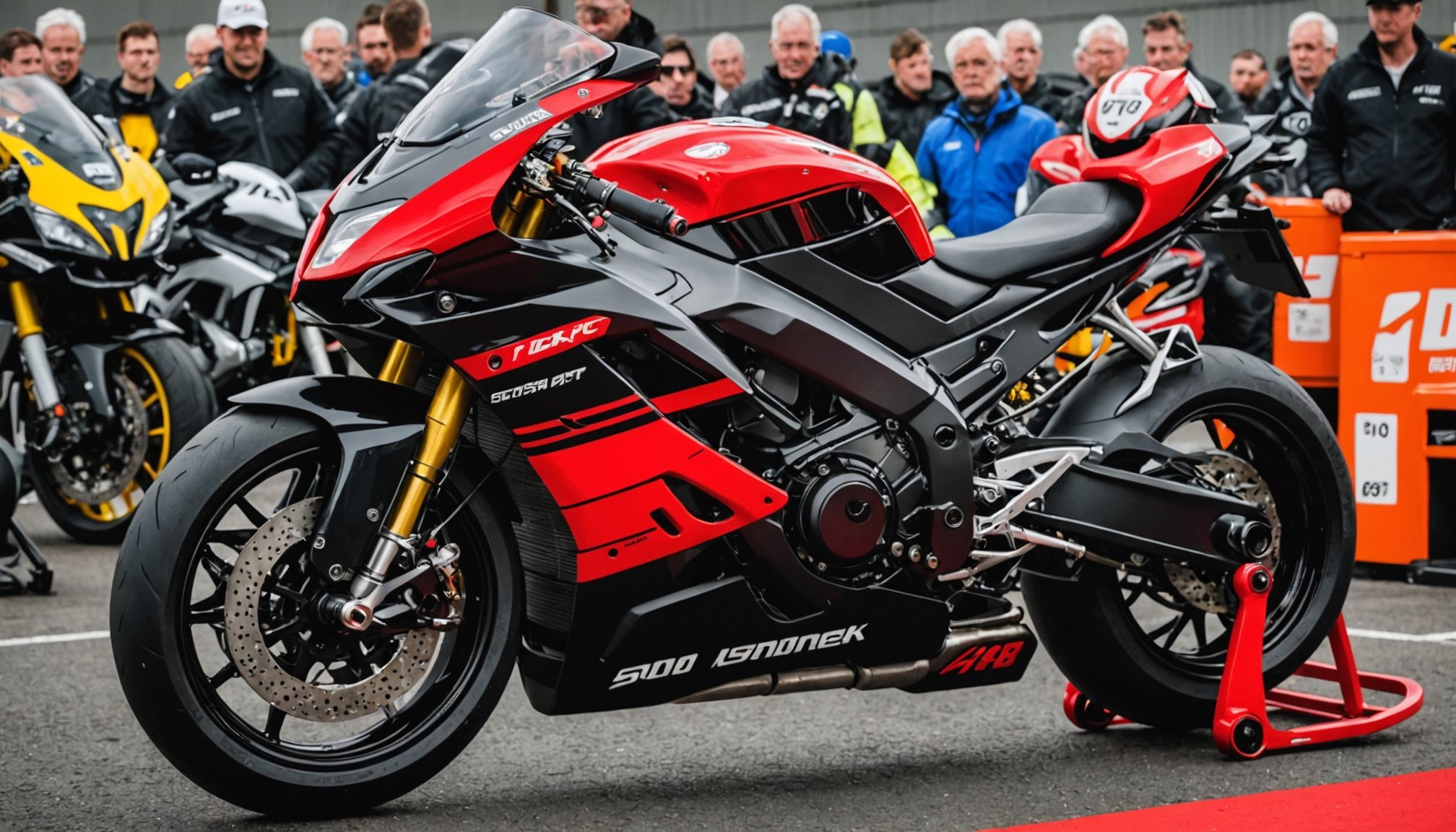Overview of Racing Fuel Tanks for Sport Bikes
Racing fuel tanks are a critical component for sport bikes looking to boost their performance. Unlike standard tanks, these are specifically engineered to cater to the demands of high-speed racing. The primary purpose is to facilitate increased fuel capacity while maintaining efficient fuel flow to the engine, allowing riders to push their bikes to the limit.
Key features that distinguish racing fuel tanks from their standard counterparts include:
In parallel : Must-Have Essentials for Your Sport Bike Emergency Kit in the UK: Stay Prepared on the Road!
- Lightweight materials: Often constructed from titanium or carbon fibre, these tanks significantly reduce the bike’s overall weight, thereby enhancing speed and agility.
- Optimised shape: Their design typically features aerodynamic contours, which improve air flow and minimise drag.
- Enhanced fuel delivery systems: Equipped with advanced pumps and filters, these systems ensure consistent fuel supply even under intense acceleration and cornering.
In terms of design and engineering, racing fuel tanks are a marvel of modern technology. Engineers focus on precise construction methods to create tanks that are both durable and efficient. By integrating these tanks, riders can feel the substantial difference in how their motorcycles perform, experiencing heightened throttle response and more effective handling on the track.
Advantages of Increased Fuel Capacity
With expanded fuel capacity, racing bikes can undertake longer races without the frequent need for refueling stops. This advantage can significantly affect race strategy, allowing riders to maintain momentum and conserve time that would otherwise be consumed during pit stops. By enabling a seamless race experience, this feature grants a competitive edge over opponents reliant on smaller fuel tanks.
Additional reading : Must-Have Essentials for Your Sport Bike Emergency Kit in the UK: Stay Prepared on the Road!
Long races necessitate strategic planning; larger fuel tanks allow racers to optimize their positioning and outsmart competitors. Without frequent fuel stops, riders can focus more on speed and timing rather than coordinating with pit crews. This efficiency in strategy bolsters a rider’s control over race dynamics, presenting an opportunity to not just finish ahead but to anticipate and dictate the flow of the competition.
Weight distribution becomes a pivotal aspect when considering increased fuel capacity. Proper alignment of fuel weight can aid in better grip and management of motorcycles during sharp turns and accelerations. In races such as the Dakar Rally, where larger fuel tanks have proven essential, fuel capacity often determines the rider’s ability to complete long races without faltering due to unplanned stops or equipment failure.
Impact on Weight Distribution
Understanding the intricacies of weight distribution is paramount in the realm of racing. The way a vehicle’s weight is balanced affects not only its handling but also its overall race performance. A well-balanced car remains more stable and predictable at high speeds, making it a crucial factor for any racing team aiming for success.
Importance of Weight Distribution in Racing
Weight distribution plays a pivotal role in a car’s handling characteristics. When weight is evenly distributed, it ensures that all tyres maintain optimal contact with the ground, enhancing grip and stability. In racing scenarios, this balance allows for sharper turns and more consistent lap times, ultimately improving race performance.
Case Studies: Optimal Weight Redistribution
Consider revolutionary case studies where optimal weight redistribution transformed race outcomes. By strategically placing components like fuel tanks and engines, teams achieved superior balance. These adjustments resulted in enhanced handling, particularly in aggressive cornering situations. This showcases the tangible benefits of well-thought-out weight management strategies.
Effects on Handling and Cornering
Proper weight distribution significantly influences how a vehicle handles corners. Fuel placement is a critical factor; shifting fuel slightly can dramatically alter a car’s dynamics, leading to more responsive steering and reduced understeer. The benefits of improved cornering thanks to effective weight management cannot be understated, often shaving valuable seconds off lap times.
Performance Efficiency Metrics
When evaluating performance efficiency in the context of racing, the impact of racing fuel tanks is substantial. These specialized tanks are designed to enhance fuel consumption by optimizing the use of every drop. This increased efficiency translates into faster lap times and improved overall speed.
Transitioning from standard tanks to racing tanks shows a marked improvement in performance metrics. On average, racing fuel tanks can increase fuel efficiency by up to 15% compared to their standard counterparts. This improvement helps in maximizing speed, as less time is needed for refueling, allowing for continuous acceleration and momentum on the track.
Statistically, racers using these upgraded tanks witness a reduction in lap times by approximately 5-7%. This decrease is critical in competitive scenarios where every millisecond counts. Enhancing fuel consumption not only means fewer pit stops but also the ability to maintain optimum speed levels throughout the race.
In conclusion, for those looking to push the boundaries of performance efficiency, investing in racing fuel tanks provides tangible advantages. These benefits underscore the importance of integrating high-quality equipment in racing to achieve peak performance efficiently and effectively.
Regulatory Considerations for UK Racing Tracks
When it comes to racing regulations in the UK, understanding the intricate framework of rules is crucial. For any modifications, including those to fuel tanks on UK tracks, compliance is not just a suggestion—it’s a mandate. The guidelines set by governing bodies ensure both safety and fairness in motorsport events.
To navigate these regulations effectively, both racers and manufacturers must meet stringent compliance standards. This involves adhering to specific procedures for fuel tank design and installation to minimise any risks during races. Staying aligned with these standards demands thorough documentation and regular updates on regulatory changes.
Falling short in meeting these regulations can have serious consequences. Non-compliance can lead to fines, disqualification of racers, or even a ban from future races. It is, therefore, imperative to remain informed about any adjustments in racing regulations. Racers and manufacturers can do this through:
- Regularly reviewing updates from UK tracks regulatory bodies.
- Participating in compliance workshops.
- Consulting with experts for interpretations of complex rules.
Finding reliable resources and experts is key to avoiding pitfalls, ensuring all modifications lead to a smooth race day without regulatory hiccups. By upholding these standards, races remain competitive and safe for all involved.
Real-World Examples and Comparisons
In the world of high-speed racing, sport bikes with racing fuel tanks often see real benefits. Racing fuel tanks are used in various competitive environments, like MotoGP and World Superbike. These settings demand the best performance and efficiency from a sport bike.
A common question is: How do racing fuel tanks improve performance? The answer lies in their ability to reduce bike weight while maximizing fuel capacity. This provides enhanced fuel efficiency and stability, especially crucial in long races. In numerous cases, racers have reported that the racing fuel tanks allow for tighter manoeuvres and quicker acceleration.
Regarding sport bike comparisons, performance differences between standard and racing fuel tanks are notable. While standard tanks prioritize general use and convenience, racing tanks are performance-oriented. They are lighter and often made from advanced materials like carbon fibre. Additionally, feedback from professional racers and teams frequently highlights enhanced control and better fuel management with these modifications.
For a performance analysis, it’s evident that sport bikes equipped with racing fuel tanks demonstrate superior lap times and agility. This is attributed to the reduction in weight and optimized handling characteristics. Consequently, such fuel tanks have become an integral part of competitive racing strategies, as confirmed through insights from various racing professionals.
Expert Insights and Technical Specifications
Choosing the right racing fuel tank extends beyond personal preference and budget. Industry experts emphasize the importance of aligning with technical specifications and industry standards that ensure safety and performance. A key insight is the significance of material choices; aluminum and composite tanks are often recommended for their strength and lightweight properties. Furthermore, experts suggest considering the size and shape of the tank in relation to your vehicle’s design to optimize balance and fuel usage.
Technical specifications such as fuel capacity, compatibility with different fuel types, and installation requirements must be considered to prevent any performance discrepancies. When evaluating racing fuel tanks, double-check for compliance with safety standards, such as FIA or SFI rating, which ensure the tank has passed rigorous testing procedures.
For those seeking reliability and quality, reputable manufacturers like ATL, Fuel Safe, and Pyrotect consistently receive positive feedback from experts and users alike. Their products are designed to meet high industry standards, offering a blend of performance and durability. Keep these insights and technical specifications in mind when selecting the ideal racing fuel tank to enhance your vehicle’s performance and ensure your safety on the track.











